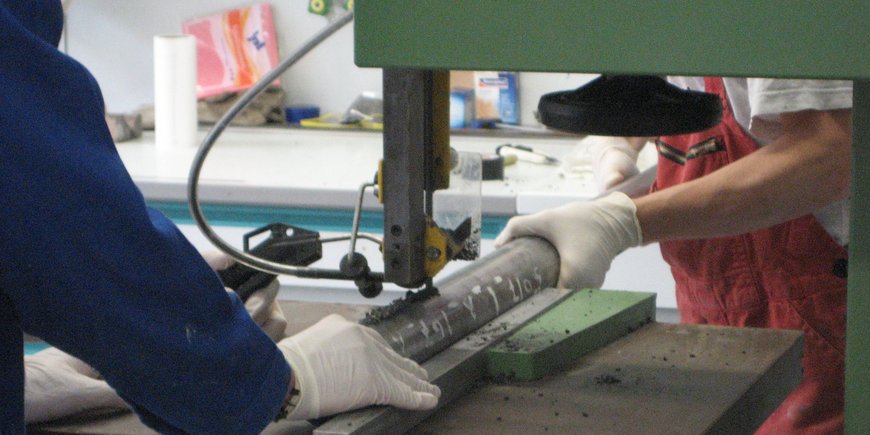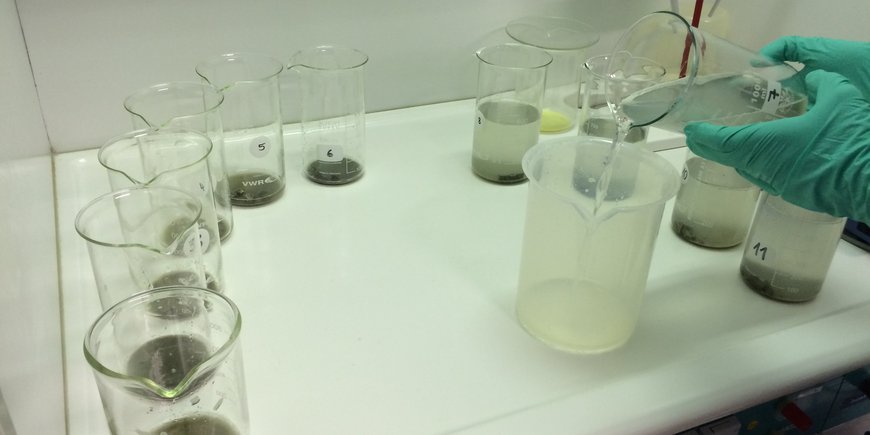One of the largest eruptions of the Italian Campi Flegrei supervolcano, not far from present-day Naples, took place around 39,850 years ago. It was also one of the largest eruptions in the Mediterranean region in the last 200,000 years, during which the volcanic ash known as Campanian ignimbrite (CI) was thrown up to 40 km into the atmosphere and spread over Eastern Europe and the central and northern Mediterranean region in some places to a thickness of several centimeters. This special volcanic ash (CI tephra) is still found today. Its unique chemical composition allows it to be identified and used as a time marker. The tiny volcanic glass particles can indicate how quickly regions reacted to past climate changes. Scientists from the German Research Centre for Geosciences, GEOMAR and the University of Potsdam have now been able to identify the CI tephra in sediments from the Dead Sea over 2300 km away from its place of origin.
The discovery sheds light on the timing of the abrupt climate shift that accompanied the cold Heinrich Event 4 in the Mediterranean region. The discovery also calls into question the previously assumed hypothesis that the changeover to both colder and drier environmental conditions was roughly synchronized regionally. The study was recently published in Scientific Reports. The DFG-funded project is entitled: “Tephrochronological synchronization of ICDP sediment cores from the Dead Sea and Lake Van in the eastern Mediterranean for the last 130,000 years” │ TephroMed.
The sediments of the Dead Sea as a climate time machine
Sediments are excellent at preserving climatic and environmental shifts of the past. For this reason, as part of the International Continental Drilling Program (ICDP), a core containing over 450 meters of sediment was taken from the middle of the Dead Sea in 2011. The TephroMed project has now made it possible to examine this sediment for individual volcanic glasses, including the Campanian ignimbrite. Rebecca Kearney, Markus Schwab and other colleagues from the GFZ, GEOMAR and the University of Potsdam were thus able to look back in great detail to the period 40,000 to 38,000 years ago.
The Campanian ignimbrite as a synchronous time marker
As the large eruption of the Campi Flegrei volcano is well dated and can be found in many sedimentary archives, it represents a detailed time marker for the Mediterranean region. The enormous volcanic eruption falls into the period of the so-called Heinrich Event 4 (HE4). In specialist circles, this refers to the release of a large number of icebergs into the North Atlantic, in this case from the North American Laurentide Ice Sheet, which once covered the entire eastern part of present-day Canada, among other places. With the release of the icebergs, the freshwater inflow into the North Atlantic increased enormously, the ocean circulation changed and had a knock-on effect with shifts in atmospheric circulation. This caused an abrupt climate change in the entire Northern hemisphere. In the Mediterranean region, this climate shift led to cooler and drier environmental conditions, which can be recognized in numerous Mediterranean sediment and pollen archives.
The eruption of the Campanian ignimbrite helps to reconcile many Mediterranean sedimentary archives and shows that the environment was already cooler and drier in response to Heinrich Event 4, particularly in the northern Mediterranean.
However, wetter conditions prevailed in the Dead Sea region where the Campanian ignimbrite was found, as the sediments characteristic of high freshwater input show. The sediments examined in the project show that ~40,000 years ago, a lot of freshwater from local precipitation flowed into the Dead Sea, which is an important indication of a generally more humid climate. Elsewhere in Europe, the drier (and colder) conditions already prevailed. The reason for the contrasting trends in this region is a delay in the southward shift of atmospheric circulation changes associated with HE4. Because the Dead Sea is the most southeasterly sedimentary archive, it may have taken longer for the gradual southward shift in atmospheric circulation to affect the Dead Sea environment.
“In this new study, we were able for the first time to accurately determine the delay in local environmental changes of the Dead Sea with respect to HE4, which is only revealed by using the Campanian ignimbrite as an independent time marker,” says Rebecca Kearney, lead author of the study and postdoc of Section 4.3 “Climate Dynamics and Landscape Evolution” at the German Research Centre for Geosciences, Potsdam.
Implications for future climate scenarios
These results show that there are local differences in the time of environmental response to large-scale climatic shifts. "The use of the Campanian ignimbrite is a powerful tool to understand the timing of these responses. Studies like this will help improve current computer models for predicting future climate scenarios. They will also shed light on the environmental conditions around the Mediterranean at the time when anatomically modern humans were becoming firmly established in Europe,” says Markus Schwab, Co-PI (Principal Investigator) of the project and head of the Laboratory for Tephra Analytics of Section 4.3 at GFZ.
Original study: Rebecca J. Kearney, Markus J. Schwab, Daniel Redant, Ina Neugebauer, Oona Appelt, Cecile Blanchet, Jan Fietzke, Christina Günter, Daniela J. M. Müller, Rik Tjallingii & Achim Brauer (2024): Identification of the Campanian Ignimbrite in the Dead Sea and consequent time‑transgressive hydroclimatic shifts in the Eastern Mediterranean. Vol.:(0123456789). Scientific Reports | (2024) 14:12114 | https://doi.org/10.1038/s41598-024-59639-7


![[Translate to English:] [Translate to English:] Totes Meer gesehen von einem Hügel am Ufer](/fileadmin/_processed_/0/f/csm_20240612-web_AdobeStock_151245578_47817d4c23.jpeg)
![[Translate to English:] Bluish sky, platform on the water, illuminated at night](/fileadmin/_processed_/f/a/csm_1_night_shift_drilling_platform_IN_4c94bc632d.jpeg)

![[Translate to English:] Sediment core, halved](/fileadmin/_processed_/7/8/csm_3_opening_half_cores_RH_4e8a058f14.jpeg)

![[Translate to English:] Transparent piece of volcanic glass, microscopically small, approx. 50 nanometres in size](/fileadmin/_processed_/8/4/csm_Kampanischer_Ignimbrit2.jpg_c069b2f133.png)
![[Translate to English:] Group photo](/fileadmin/_processed_/9/0/csm_5_core_opening_meeting_gruppe_EG_cc7fab9b32.jpeg)











![[Translate to English:] [Translate to English:] Abror Gafurov von dem Schriftzug "Welcome to Azerbaijan" und den UN und COP Logos](/fileadmin/_processed_/2/5/csm_2024_11_Baku_COP29_Abror_Gafurov_1042faec82.jpeg)


![[Translate to English:] Martin Herold standing in front of the library on the Telegrafenberg](/fileadmin/_processed_/c/d/csm_Martin_Herold_d385ee4dd9.jpeg)
![[Translate to English:] Many people are listening to a presentation in the GFZ lecture hall.](/fileadmin/_processed_/c/a/csm_1_Bild1_hell_b9c0e9f5ed.jpeg)






![[Translate to English:] Both scientists sitting on stools in front of a wall of books in the Telegrafenberg library](/fileadmin/_processed_/6/6/csm_Buiter_Castell_DORA_4_e87cb1ea18.jpeg)
![[Translate to English:] Gruppenbild mit 4 Personen](/fileadmin/_processed_/8/d/csm_20241017_GFZ-Emmerman-Medal-005_web_reinhardtundsommer_21a414fa4a.jpeg)






![[Translate to English:] Ice landscape with five red tents](/fileadmin/_processed_/8/9/csm_Zeltlager_auf_dem_Eis_Urheberin_Jenine_McCutcheon_5ced2d523b.jpeg)


